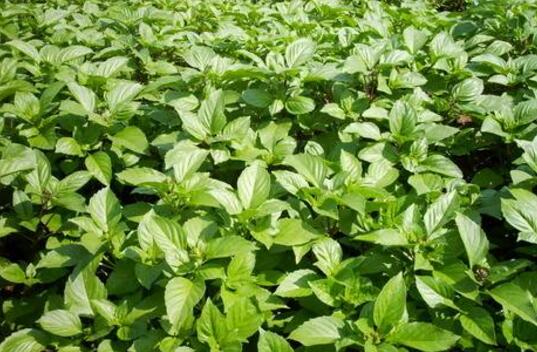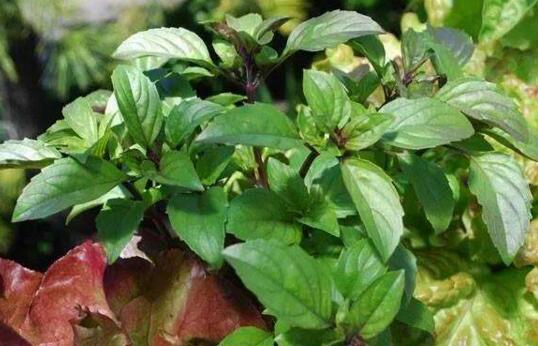How to water basil, how often is basil watered / watering does not need too much / attached method
Through basil's breeding method, we know that it is a plant that likes a dry environment, and it is necessary to create such an environment as far as possible in the usual maintenance process. Watering has become a key link, neither more watering nor long-term non-watering. So how does basil water? How often does basil water? These are the questions that many flower friends are considering. The editor will answer them for you.
Does basil need a lot of water?

Basil does not need to be watered every day, usually maintenance can make the soil slightly dry, if found that the soil can not be pinched into a ball, it means that the soil has been relatively dry, this time needs timely watering, watering needs to pay attention to watering thoroughly.
How to water basil
Due to different growth stages of basil for water requirements are different, coupled with climate changes, so watering time can not be generalized, below we will introduce in detail from the germination stage, young plant stage, growth period.
How often is basil watered?
1. Germination period
Basil needs a period of time to take root and sprout after reproduction. in this process, the soil needs to be kept moist, but it does not need to be watered frequently or heavily. You can spray some water on the soil surface every day, and then cover it with plastic film to keep warm. Basil can germinate smoothly.
2. Young plant stage
Basil, which has just been planted in the pot, can be watered once every 5-7 days, and the soil should not be too dry to ensure that the soil is slightly moist. In addition, the water demand of young plants in the whole stage is not as good as that of basil in the peak growth period, so watering does not need to be too frequent.
3. Growth period
⑴, Spring and Autumn
Usually watering is 4-5 days, according to the dry and wet condition of the soil to choose the watering time, if the soil dries faster, then it is necessary to replenish water in time. In addition, there are more Rain Water in spring in some places, how to water basil at this time? The answer is that watering can be stopped during the rainy season.
⑵, summer watering
In addition to being absorbed, a lot of water in the soil will evaporate in summer. In order to keep the soil moist, water is usually watered every 2-3 days, preferably in the morning or evening, which is more conducive to the full absorption of water.
How to water ⑶ and basil in winter
In most areas, the winter temperature is not conducive to basil growth, so the need for heat preservation in winter, watering should also be reduced, can be watered every 10-15 days, the time can be chosen in the sunny afternoon, at the same time to pay attention to the water temperature is not too low.
How to raise basil, basil breeding methods and precautions / temperature and light are very important.
Although basil leaf has a lot of efficacy and function, in order to bring all these benefits into full play, it is necessary to ensure that basil grows healthily. As basil is sensitive to temperature, it is necessary to master certain skills when breeding, so how to raise basil? Let's take a look at basil's breeding methods and matters needing attention.
The growing environment of basil
Before we understand how basil is raised, we need to have a preliminary understanding of its suitable growth environment. Basil is sensitive to temperature. It grows rapidly in a warm and dry environment, but it is not resistant to cold. In addition, it is more resistant to drought but not resistant to water and moisture. It likes fertile soil with good drainage and general requirements for light.
How to raise basil
1. Soil requirements
Basil prefers fertile soil. Humus soil and sandy soil are the best when cultivated. They can be mixed with garden soil, river sand and so on. If potted, vermiculite and peat soil can be used to make substrates.
2. Temperature requirement
Basil is a plant that is afraid of the cold. It likes a warm environment, and the most suitable temperature is between 15 and 28 degrees, so it grows faster in spring, summer and autumn, but it needs to keep the temperature above 5 degrees in winter to avoid freezing damage to the plant.
3. Lighting conditions
In basil's breeding methods and precautions, basil's requirement for light is to have enough sunlight. It is a kind of sun-loving plant. If it lacks light, it will cause the leaves to dim and grow slowly, so it should be placed in a bright or full-light place during normal management.
4. Watering method
Watering should let the soil dry, because basil likes the dry environment, its drought resistance is strong, usually watering 3-4 days, do not let the soil too dry, in addition to the need to spray water frequently when the temperature is high in summer, spray water to the leaves as little as possible at other times to avoid excessive humidity.
5. Pest control
The main pests that harm basil are aphids, leaf miners, snails, and so on, while the diseases are fungal wilt, and the main way to prevent and cure them is to do a good job in environmental hygiene at ordinary times, so as not to let the environment lack light, too low temperature, and too high humidity. Diseases and insect pests should be treated with drugs in time.
Breeding methods and matters needing attention of basil
1. The soil does not accumulate water.
When watering, do not pour too much at one time, as long as make sure that the upper and lower parts of the soil are wet, do not let the root soak in the water, easy to cause root rot. At the same time to ensure that the soil drainage is good, to avoid the rainy season when the water can not be discharged in time.
2. there is no lack of light.
Basil leaves green to play its maximum value, to do this requires enough light, so do not let the environment lack of light, especially basil can not be placed in the house where there is neither scattered light nor light, otherwise basil will soon wither and die.
3. The environment should be ventilated
One way to maintain environmental hygiene is to keep the air well ventilated in order to avoid the breeding of germs and harmful microorganisms. if basil is always in an airtight environment, its chances of diseases and insect pests will increase exponentially. The harm to its health is enormous.
How to plant basil planting methods and matters needing attention
Presumably everyone is no stranger to basil, it is a kind of fragrant plant with both medicine and food, and it is often used as a food on various tables. However, as a seasoning, fresh basil is the best, so a lot of powder began to grow at home. But you still have a lot of questions about how to plant it correctly. The following editor will answer them one by one.
How to grow basil
I. planting methods
Sowing time: if the south can choose from March to April, if the north can choose from late April to May.
Sown soil: the soil can be mixed with 1 part of peat soil + 1 part of perlite + 1 part of vermiculite.
Second, preparation before sowing
Seeds: you can buy the varieties you want, basil is also divided into several varieties, when buying seeds, you can choose the varieties you want.
Soil: gently compacting the soil with your hands is conducive to the discharge of air from the soil, and then all the soil is watered through without stagnant water. This is beneficial to the germination of seeds.
Third, the steps of sowing
1. Put 1 or 2 seeds in each flowerpot, cover a layer of soil above, and then cover it with plastic film. At this time, the soil should be kept moist.
2. put the flowerpot in a sunny place, and open the plastic film to spray water into the flowerpot every day to keep the soil moist, twice a day.
3. When a small bud is born, the plastic film can be removed completely.
4. Water it every day to keep the soil moist. Don't let the soil dry at this time.
IV. Transplant and colonization
When it grows one or two mature leaves, it can be transplanted and planted, but it must be placed in a sunny place, which is very beneficial to its growth.
After that, it can be cultured in the normal way.
Planting method of basil and matters needing attention
1. Ploughing and topdressing
When the basil seedlings were 6-10 cm high, the seedlings were interspersed and replenished, and 2-3 seedlings were left in each hole, and 1 plant was left in strip sowing according to 10 cm. Generally ploughing and weeding twice, the first time in 10-20 days after emergence, shallow hoe topsoil. The second time is from early May to early June, before the seedlings are closed, and after each intertillage, human and animal dung water should be applied. If you are afraid of drought in the seedling stage, you should pay attention to timely watering.
2. Harvest time
Basil stems and leaves are harvested from July to August, cut the whole grass, remove fine roots and impurities, and dry. When the plant is 20 cm high and the ridge is closed, the unbolted young twigs are harvested at the front end, with a length of 5-10 cm, once every 7-15 days. The essential oil is extracted when the inflorescence is ready.
3. Harvesting and processing
Basil was harvested with a sickle 20-25 cm above the ground to avoid shaking the root system so as not to affect the ability of regeneration, and then strengthen fertilizer and water management to promote its re-germination of new stems and leaves. Processing should be carried out as soon as possible after harvest to prevent the wound and leaves from turning brown and yellowing, affecting the quality of essential oil.
4. Pest control
Basil mainly includes aphids, Japanese beetles, thrips, leaf miners, snails and slugs. Organic cultivation can be used to spray away aphids and to catch Japanese beetles by hand and throw them into soapy water. Slugs and snails can be trapped in small beer containers or tied to copper at 5 cm (10 cm) from the base of the plant, which retreats due to the interaction between copper and slug mucus.
5. Disease control
Basil is highly infected with fungal wilt in terms of disease. the pathogen invades from the microtubule bundles of roots, hinders plant growth and leads to leaf withering. F1 hybrid varieties resistant to fungi can be selected for general field cultivation. In addition, high humidity and poor drainage are also easy to infect fungal leaf spots.
Does basil bloom?
The answer is that it will definitely open. Basil can open purple or white flowers, small broken flowers are very lovely. Usually, a flower branch of basil is covered with a bunch of flowers, one layer at a time. The petals are wide open and the long filaments hang down, feeling like a villain dancing.
Basil's florescence is usually from July to September every year. When basil blossoms, a flower branch blossoms very luxuriantly. After the flowering period, it is the fruit stage of basil. When the flower branches of basil become dry, the seeds will be harvested and sown next year.
How to water basil
1. During the germination period
During this period, the basin soil should be kept in a wet state, but not too wet. At this time, the environment also needs a certain amount of humidity, so it will sprout more quickly. It can be covered with plastic film on the flowerpot and open regularly to pour some water into the basin soil.
2. During the seedling period
Careful care should be taken during the seedling period. At this time, I am most afraid that the soil is too dry, which is not helpful to the growth of the seedlings, so the soil can be kept moist all the time.
3. Summer
Summer is characterized by high temperature and high heat, which can be watered once a day, and the best time to water is before the sun rises completely in the early morning, when watering can make plants and soil absorb water more thoroughly. But if the soil is dry at night, you can carry out a watering, and if you encounter bad weather such as rain, you can delay watering or prolong the watering interval.
4. Winter
In winter, if the culture temperature can be maintained at a normal temperature, then it can be watered normally, but if the temperature is low, the basin soil can be kept slightly dry.
There is a small balcony at home in addition to planting ornamental plants to decorate the home environment, it is not impossible to plant a small pot of fruit and vegetable plants, basil is a very good choice, its small body contains infinite power, in edible and medicinal value has a very good effect.
- Prev

Basil how to fertilize, four tips to make fertilization easier / stop fertilization in winter
Basil is a relatively strong plant, it has relatively low requirements for fertilizer, as long as it ensures that the soil is fertile enough, it can grow well, but in order to make the leaves greener, it can be fertilized reasonably in basil's breeding method. so how does basil fertilize? The editor will tell you the answer.
- Next

What's going on with the falling leaves of Goose Feet? Improper watering, light discomfort/moving flowerpot damage
Goose foot wood, also known as duck foot wood, it leaves strange, like goose and duck feet, looks particularly beautiful. Because goosefoot evergreen, so deeply loved by flower friends, it is also potted at home by many families. But in the breeding process, because of lack of management, many people will encounter the phenomenon of falling leaves.
Related
- Fuxing push coffee new agricultural production and marketing class: lack of small-scale processing plants
- Jujube rice field leisure farm deep ploughing Yilan for five years to create a space for organic food and play
- Nongyu Farm-A trial of organic papaya for brave women with advanced technology
- Four points for attention in the prevention and control of diseases and insect pests of edible fungi
- How to add nutrient solution to Edible Fungi
- Is there any good way to control edible fungus mites?
- Open Inoculation Technology of Edible Fungi
- Is there any clever way to use fertilizer for edible fungus in winter?
- What agents are used to kill the pathogens of edible fungi in the mushroom shed?
- Rapid drying of Edible Fungi

